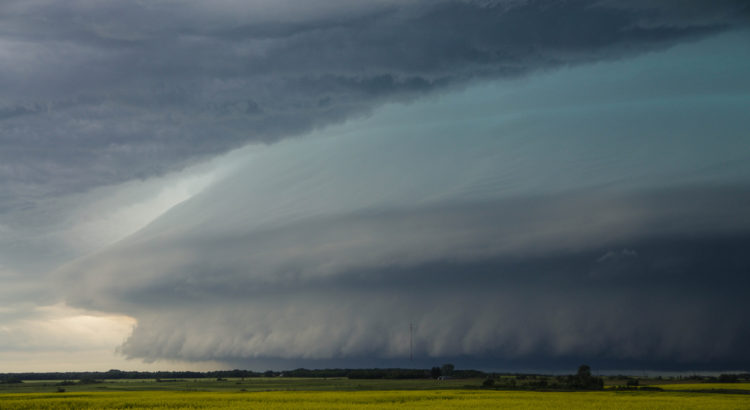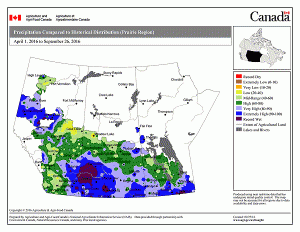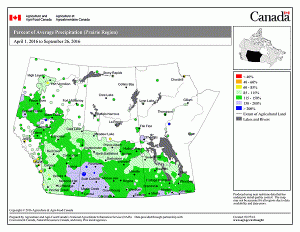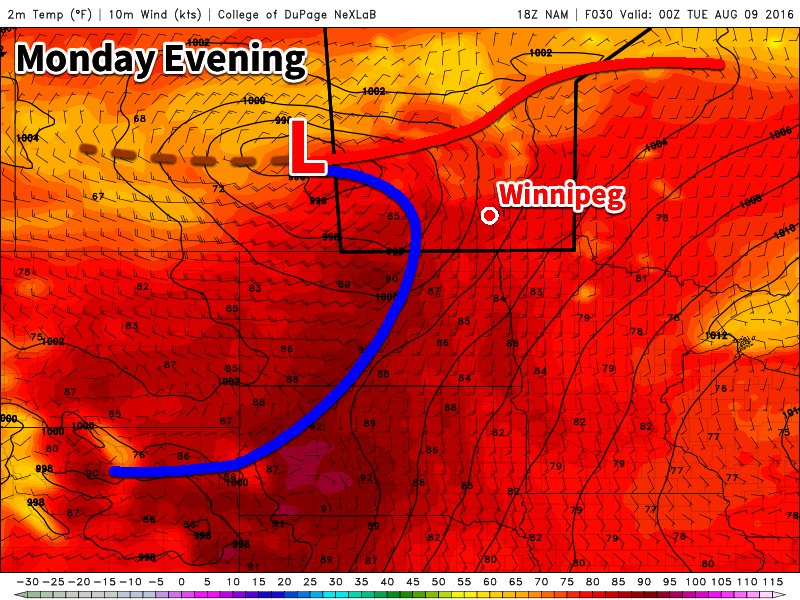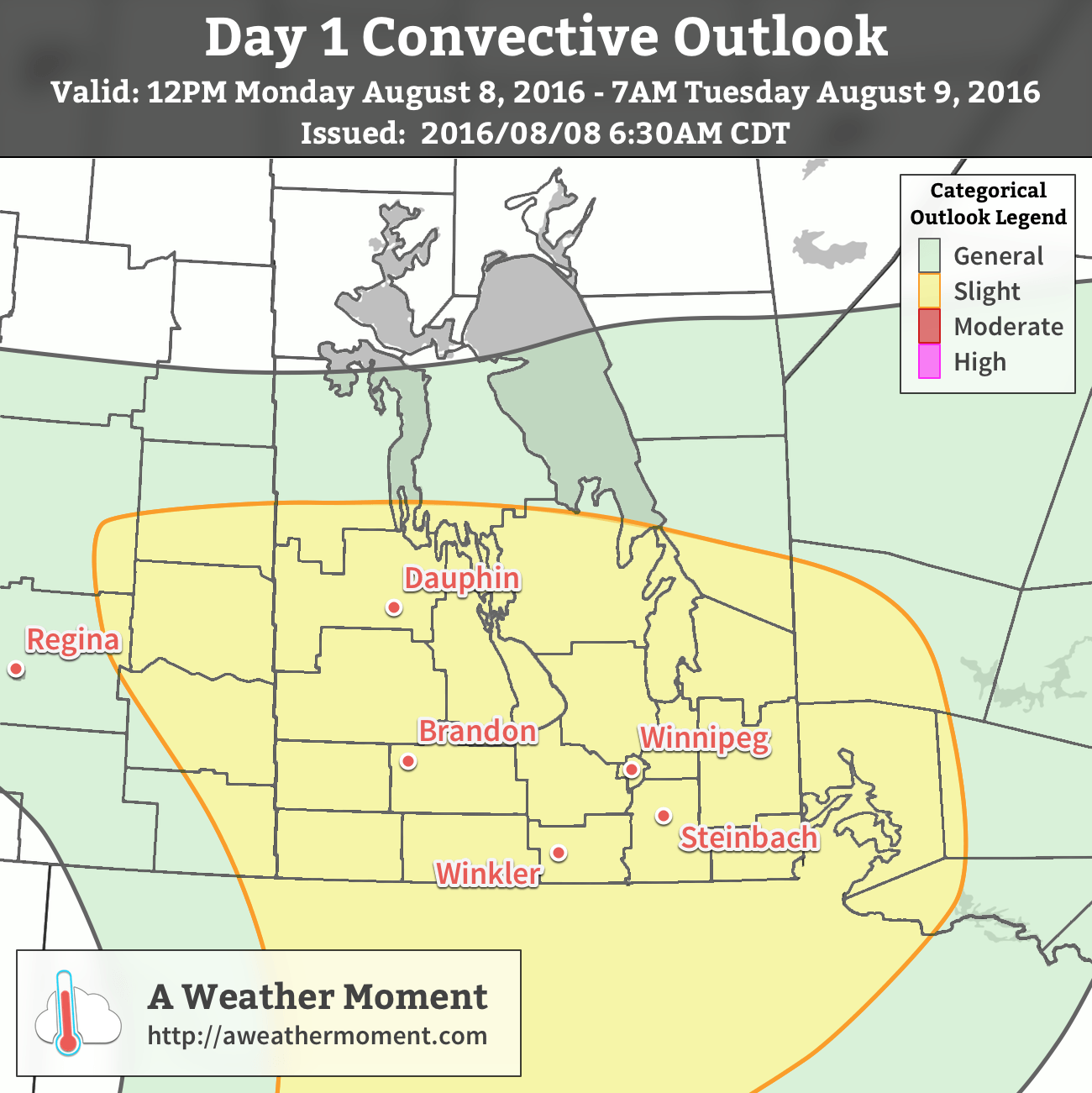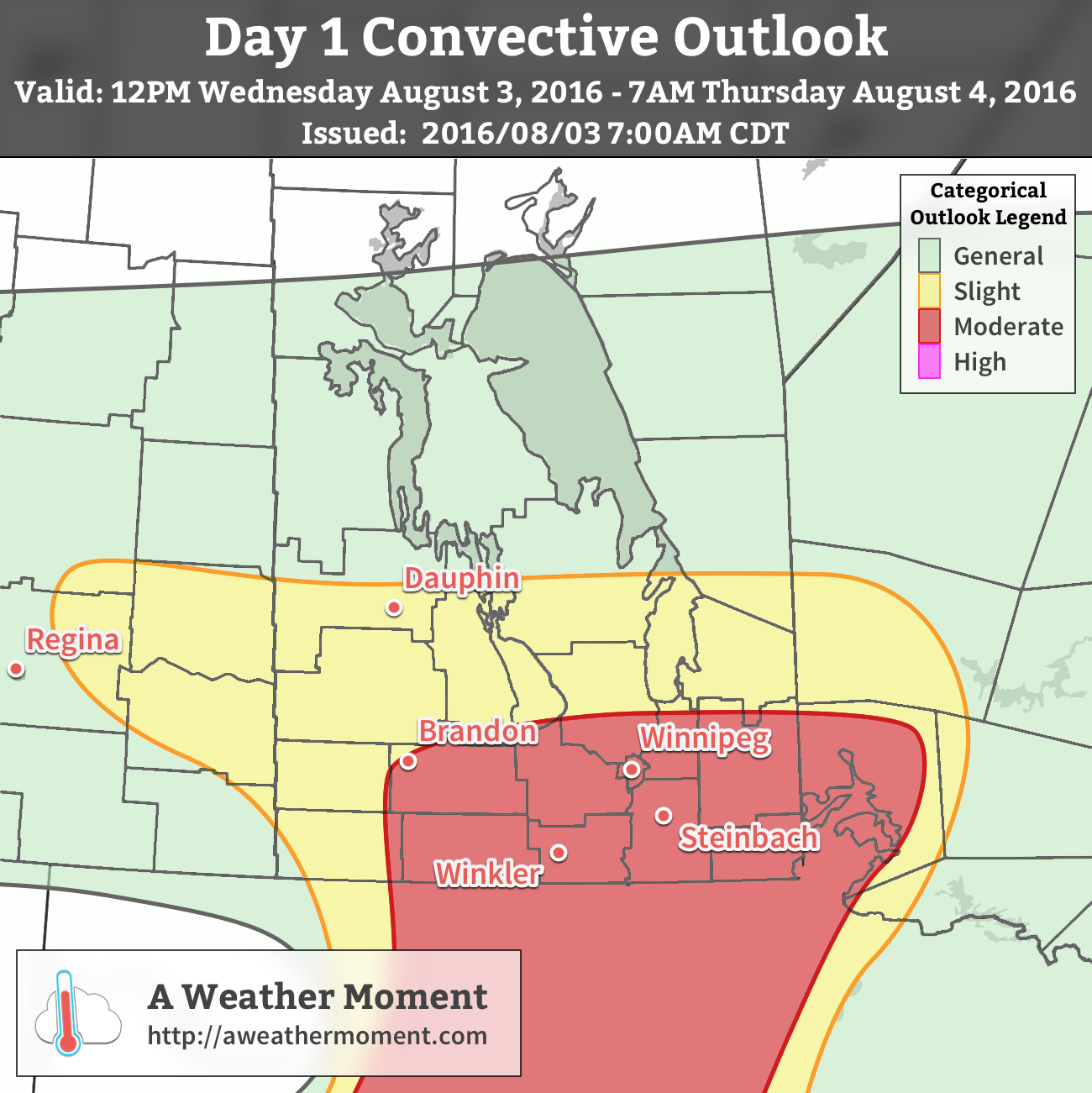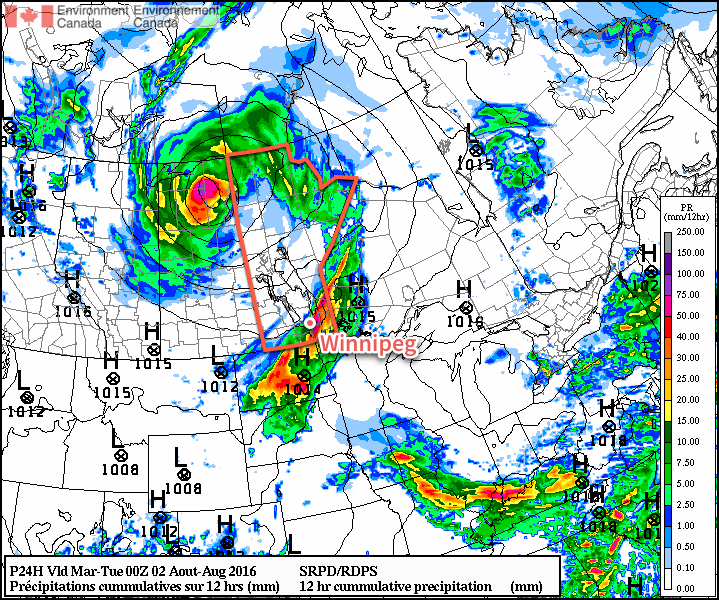Summer 2016 will be remembered for its intense and frequent thunderstorm activity which caused several tens of millions of dollars in damage across the Prairies. Manitoba experienced its fair share of the action with multiple damaging wind, flooding rain, tornado and damaging hail events – the most some areas have seen in years. Humidity was high, which possibly was one factor that helped fuel a more intense season. Temperatures were pleasant – not too hot and not too chilly. In fact, temperatures averaged bang on normal in Winnipeg.
| Average or Total | Deviation from Normal | Rank Since 1873 | |
|---|---|---|---|
| High Temperature | 24.6°C | -0.1 | Equal to median |
| Mean Temperature | 18.4°C | 0.0 | Tied 65th warmest |
| Low Temperature | 12.2°C | +0.2 | Tied 47th warmest |
| Rainfall | 231.5mm | -16.0 (-6%) | 63rd rainiest |
Overall, it was a wet summer, except for a few isolated locations. Winnipeg’s airport actually saw slightly drier than normal conditions from June to August, but this was mainly a result of a dry August when storms mostly missed the location. June and July were wetter than normal.
Wet Summer For Most
Thunderstorms were a regular occurrence throughout not only southern Manitoba but also Saskatchewan and Alberta this summer. Severe thunderstorms occurred almost daily across the Prairies with only a handful of days seeing no severe weather.
Thanks to the active weather, rainfall amounts were above normal throughout most of the three Prairie provinces. Only localized portions of northeastern Manitoba, central Saskatchewan and southwestern Alberta saw below normal rainfall. The wettest areas relative to normal were the southern Red River Valley in Manitoba, southwestern Saskatchewan and southeastern and northwestern Alberta. The following two maps from Canada Drought Watch show percent of normal precipitation and precipitation percentiles for the season since April.
The highest rainfall totals from April 1 to September 8 in southern Manitoba were along the US border in the Killarney to Sprague area where 500 to 750 mm of rain fell. A secondary area of heavier rainfall also occurred east and northeast of Winnipeg with 500 to 650 mm. Letellier took top honours with a whopping 752 mm at the Manitoba Agriculture station. 18 days saw over 20 mm of rain as rounds of heavy rainfall occurred almost every few days. Farmers regularly faced overland flooding on their fields as a result. Other high rainfall totals in the area included Green Ridge with 630 mm, Vita 563 mm, Altona 568 mm, Killarney 520 to 550 mm, Steinbach 530 mm and Morden 490 to 550 mm. High rainfall totals also fell in the Whiteshell area where heavy rains at times caused serious flooding. About 620 mm of rain fell in Falcon Lake and 572 mm in Hadashville during the period. All the above rainfall totals are via Manitoba Agriculture, Manitoba Fire and Cocorahs.
In Winnipeg, rainfall was slightly above average at the airport between April 1 and September 8 with 365 mm. Average for the period is close to 340 mm. Higher totals fell in other parts of the city however, with 420 to 470 mm in western and southern sections.
Year of Severe Thunderstorms and Tornadoes
A total of 16 tornadoes occurred in Manitoba this year; 1 in May, 2 in June, 5 in July and 8 in August. This is up from 11 tornadoes last year and the most tornadoes in a year in a couple of decades (the 1980’s to early 90’s was a busy period). Manitoba also had the most tornadoes in Canada this year. There were a number of multi-tornado-day events including 4 on August 8 and 3 on July 20 and August 3.
There were many notable hail and wind events this summer across southern Manitoba, too many to list. As a result, I have prepared a list below of what I believe were the top 5 events of the summer.
Top Thunderstorm Events
I have listed, in chronological order, what I believe were the top thunderstorm events of the summer in southern Manitoba
June 24/25 Derecho
A rare derecho event occurred from the evening of June 24th into the overnight on June 25th. A severe thunderstorm complex moved in from Montana and raced across southern Manitoba. A derecho is one of the most intense thunderstorm events with respect to wind. By definition, it is a thunderstorm complex that produces winds of at least 50 knots (93km/h) along a swath at least 400 km long and whose life span exceeds 6 hours. In addition, no longer than 2-3 hours must pass between successive wind reports. These criteria were met during the June 24/25 event. The following map shows AWM`s Convective Outlook Verification for the event and is included here to show where the severe events were recorded.

Winds in excess of 90 km/h occurred in a swath from Melita to Carberry to Carman to Saint Adolphe with the derecho. Melita was pummelled with a maximum recorded gust of 124 km/h! Trees, fences and homes suffered damage. Gusts over 100 km/h occurred in Deloraine (102 km/h), Waskada (107 km/h) and Carberry (102 km/h), and gusts over 90 km/h occurred in Killarney (96 km/h), Somerset (90 km/h), Ninette (90 km/h), Carman (93 km/h), Morris (91 km/h), Sanford (90 km/h) and Saint Adolphe (92 km/h). Damage was widespread and significant with snapped trees, crop damage and other property damage. Streets in some areas were littered with branches and debris the next morning.
A narrow jet (sting jet?) of winds between 90 and 110 km/h also occurred in the Brandon area behind the massive thunderstorm complex around 4 am. This was a very interesting occurrence because these winds occurred behind the storms and would be a great case study project. Brandon airport recorded a gust of 106 km/h with the event. Forrest, just north of Brandon, recorded a gust of 98 km/h. Trees were snapped and uprooted, which caught many by surprise because there was no thunder or lightning and only light sprinkles occurring at the time.
Mess in Carman with Twigs n branches everywhere and found this tree toppled. Trees snapped 10 km east #mbstorm pic.twitter.com/hBHrLEg8Z0
— Julien C (@jjcwpg) June 25, 2016
Wind was not the only severe weather with the storms. Toonie sized hail occurred south of Killarney and nickel sized hail in Winnipeg. Flooding was a problem as well. 80 to 100 mm of rain fell in the Killarney area with a swath of 50 to 80 mm northeastward to Elm Creek. Winnipeg received 25 to 40 mm with highest amounts in southern and eastern sections. Estimated wind gusts near 80 km/h also occurred in the south end as the city was brushed by the strongest winds to the south. Another swath of 50 + mm fell from Selkirk southeastward to Falcon Lake. In fact, the Falcon Lake/West Hawk Lake area received an incredible 140 to 160 mm of rain. Flooding was severe with some highways underwater and closed. Lake levels in the area were unusually high.
July 20 Supercells / Long Plain Tornado
A series of severe thunderstorms developed in southwestern Manitoba and southeastern Saskatchewan after 4 pm and raced eastward through southern Manitoba in the evening.
The storms dropped up to tennis ball sized hail in extreme southeastern Saskatchewan before entering into Manitoba. In Manitoba, numerous funnel clouds were seen with the storms west and southwest of Brandon. Two of these became landspout tornadoes near Hartney. With no damage reported, these were rated EF-0. The main story initially was the hail with toonie to tennis ball sized hail from the Melita to Brandon areas. The City of Brandon was hit hard with hail up to golf ball sized, wind gusts over 80 km/h and up to 40 mm of rain in 1 hour.
The supercells then continued eastward with incredible wind gusts and a damaging tornado south of Portage la Prairie. A summary of wind gusts is provided in the following table:
| Location | Maximum Wind Gust (km/h) |
|---|---|
| Portage Southport | 138 |
| Selkirk | 115 |
| Mountainside | 110 |
| Winnipeg Int'l Airport | 107 |
| Elm Creek | 107 |
| Starbuck | 101 |
| Gretna | 96 |
| Cartwright | 95 |
| Carberry | 94 |
| Deerwood | 93 |
The area south of Portage was worst hit with winds over 130 km/h recorded. Widespread and significant damage occurred with trees toppled and uprooted and buildings damaged. A supercell tornado also occurred at the Long Plain FN and New Rosedale Hutterite Colony south of Portage. Buildings were shifted off their foundations, roofs ripped off homes, hydro poles toppled, cars flipped, sheds and farm buildings destroyed and trees were again toppled and uprooted by the tornado. Debris was scattered across fields downwind. The tornado was rated an EF-1. According to CBC, about 150 homes were damaged and some residents remain displaced in September. A video of the tornado from a distance exists here. A timelapse of the storm coming in Winnipeg exists here.
The storm then raced east toward the Winnipeg area. The storm was one of the most ominous storms ever seen with a massive shelf cloud, nearly-constant flashes of lightning and a sky that was almost completely green. Damaging winds occurred with a gust of 107 km/h at Winnipeg International Airport and 115 km/h in Selkirk. Significant damage occurred with trees toppled and some buildings damaged. A roof was partially ripped off an apartment building in north Winnipeg. An estimated 1 million dollars in damage also occurred to a U of M professor`s equipment at the St. Andrews airport. Wind damage also occurred in the Beausejour, Anola, Treherne, Elie and Elm Creek areas. According to Manitoba Hydro [CBC], at peak, 32,000 Manitobans were without power, about 20,000 of which were in Winnipeg.
August 3 Tornado Outbreak
A series of supercell thunderstorms developed in southwestern Manitoba and North Dakota in the afternoon and persisted through the evening. The storms produced numerous tornadoes with three tornadoes in Manitoba: at least one tornado near Glenboro, one tornado west of Morden and a landspout tornado near Margaret.
The town of Glenboro was lucky as a tornado narrowly missed the town. A tornado formed south of the town after 5 pm and the storm continued to produce a tornado for close to half an hour as it continued northeastward and crossed highway 2. The tornado at one point was a massive wedge tornado northeast of town. Farm sheds and buildings were damaged or destroyed, trees were uprooted and hydro poles were toppled by the tornado. Video of tornado exists here. The storm also dumped 57 mm of rain in 1 hour in Glenboro and 54 mm in 1 hour in Holland to the east. Peak rainfall was just north of Glenboro with a 79 mm storm total recorded at a Weather Farm station.
Tornado damage at Stockton, MB pic.twitter.com/Qor1dsRgql
— Conway (@Conway30789074) August 3, 2016
The Morden area was hit hard by storms moving up from North Dakota. A wind gust of 111 km/h was recorded at the airport. Streets in the city were littered with twigs, branches and toppled trees and shingles were ripped from roofs. Streets were also flooded after 30 to 50 mm of rain fell. A tornado was also seen west of the city in pictures, but no damage directly related to the tornado was ever reported.
Wind damage also occurred in Portage la Prairie, Plum Coulee and Gretna thanks to wind gusts between 80 and 95 km/h.
Storms danced around Winnipeg during this event with only a few mm of rain recorded. Lightning was spectacular however. The storms had just scraped the south end. Saint Adolphe, a short drive south of Winnipeg, recorded 54 mm of rain in 1 hour and a wind gust of 92 km/h. Branches were taken down and some minor flooding was reported.
The low pressure system responsible for the thunderstorms on August 3 also produce slow-moving thunderstorms in the wrap-around portion of the system north of Dauphin. 150 to 190 mm of rain fell in the Ethelbert area in just 6 hours. Flooded fields were reported.
August 8 Tornado Outbreak
Supercell thunderstorms developed in Saskatchewan and moved into southern Manitoba southwest of Riding Mountain National Park, producing the largest tornado outbreak of the year in terms of number of tornadoes. Four tornadoes were confirmed, two of which were rated EF-2 and two rated EF-0. The storms, which tracked from Russell to Erickson, also dumped hail up to tennis ball sized.
Waywayseecappo FN was hit by one of the EF-2 tornadoes. Several homes were damaged or completely destroyed. A school bus was also flipped on its side. Hail up to golf ball sized also fell with the storm. Some residents were evacuated after the storm.
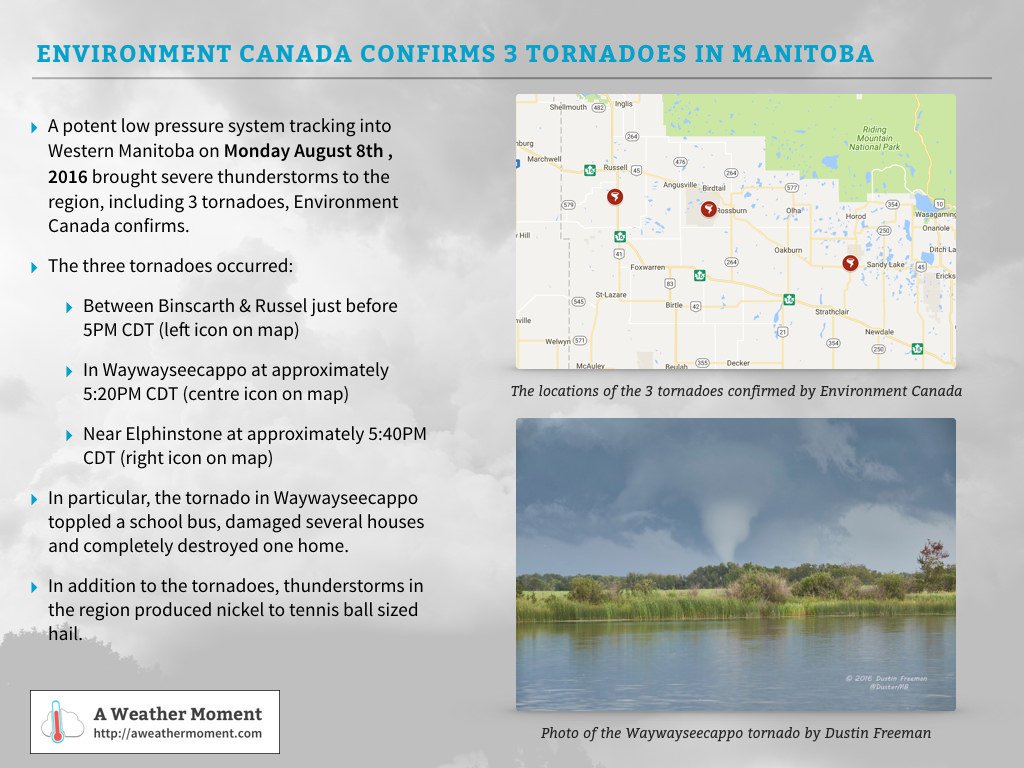
The other tornadoes were south of Russell, near Elphinstone and near Erickson. The one south of Russell was rated an EF-0 based on tree damage. The one near Elphinstone was also given an EF-0 rating due to no reports of damage. The tornado near Erickson was rated an EF-2. A long swath of forest about 500 metres wide was completely flattened (seen thanks to aerial photos from CBC) and bark ripped off trees. Swirls could be seen in the forest from above, confirming that a tornado indeed produced the damage. The tornado also damaged homes and other buildings in the area. The storms continued southeastward after the last tornado, but weakened.
High Humidity
With an average dewpoint temperature of 13.7°C, summer 2016 tied with 2005 for third most humid summer since 1953 in Winnipeg. Some might think this stat is a little surprising because the summer really wasn’t that hot. In fact, temperatures were only near normal overall and very hot days were few and far between. This was probably a good thing because otherwise, the high humidity combined with hotter temperatures would have made the summer much more unbearable.
July 20 saw the peak humidity of the summer when dewpoint temperatures rose to the 24 to 27°C range across southern Manitoba, breaking records. At Winnipeg Int’l Airport, dewpoint peaked at 25.9°C, the second highest dewpoint reading on record since 1953. The record is 26.1°C on July 17, 1966. Dewpoint temperatures reached an amazing 27°C in Carman, Winkler, Portage, Altona, Beausejour and Minnedosa. The highest reading was in Carman at 27.4°C. The heat and humidity together produced humidex values in the mid 40`s.
Hottest Day of the Year Was Outside of the Summer Season
Consistent with few very hot days this summer, the hottest day of the year was actually outside of the summer season. A high of 35.2°C on May 5th was the hottest of the year and the earliest date to reach the highest temperature of the year on record since 1872. It was also only the 12th time that our hottest day of the year was in May. The high of 35.2°C was also the earliest occurrence of temperature over 35.0°C on record since 1872. Previous earliest was May 8, 1874 with a high of 35.0°C.
| Rank | Date | High |
|---|---|---|
| 1 | May 5, 2015 | 35.2°C |
| 2 | May 7, 1891 | 34.4°C |
| 3 (tie) | May 13, 1932 | 33.3°C |
| 3 (tie) | May 13, 1977 | 32.6°C |
| 5 (tie) | May 19, 1948 | 35.0°C |
| 5 (tie) | May 19, 1992 | 34.2°C |
Warm Year and September so Far
The January to August period averaged 5.5°C in Winnipeg, tied with 1999 for 13th warmest on record since 1873. September so far is averaging just over 2 degrees above normal, making this the 14th warmer than normal September in the last 16 years. September has been and seems to continue to be warming at a rapid pace. In fact, September has warmed 1.0°C in the last 20 years, 0.7°C in the last 10 years and 0.5°C in the last 5 years, showing that warming for the month has accelerated in recent years. The 30-year 1987 to 2016 average for September is 13.4°C, up from 12.9°C in the 1981-2010 normal and the warmest Septembers have been on record. There is certainly no guarantee that this warming trend will continue forever, but what is interesting is how rapidly the month has warmed and how rare it has become to experience a chilly September.
